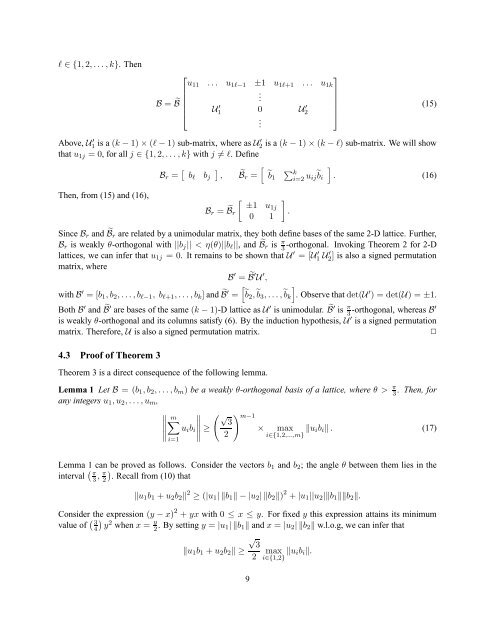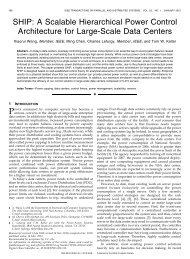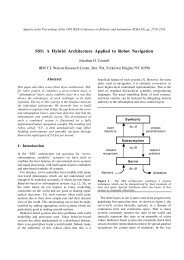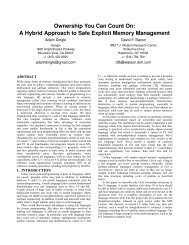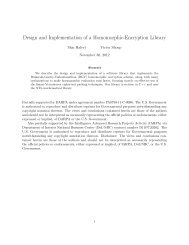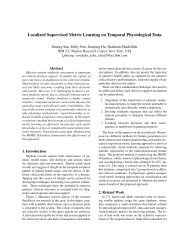On Nearly Orthogonal Lattice Bases and ... - Researcher - IBM
On Nearly Orthogonal Lattice Bases and ... - Researcher - IBM
On Nearly Orthogonal Lattice Bases and ... - Researcher - IBM
You also want an ePaper? Increase the reach of your titles
YUMPU automatically turns print PDFs into web optimized ePapers that Google loves.
l ∈ {1,2,... ,k}. Then⎡⎤u 11 ... u 1l−1 ±1 u 1l+1 ... u 1kB = ˜B.⎢⎣ U 1 ′ 0 U 2′ ⎥⎦.(15)Above, U 1 ′ is a (k − 1) × (l − 1) sub-matrix, where as U 2 ′ is a (k − 1) × (k − l) sub-matrix. We will showthat u 1j = 0, for all j ∈ {1,2,... ,k} with j ≠ l. DefineB r = [ ] [∑]b l b j , ˜Br = k ˜b1i=2 u ij˜b i . (16)Then, from (15) <strong>and</strong> (16),B r = ˜B r[ ±1 u1j0 1].Since B r <strong>and</strong> ˜B r are related by a unimodular matrix, they both define bases of the same 2-D lattice. Further,B r is weakly θ-orthogonal with ||b j || < η(θ)||b l ||, <strong>and</strong> ˜B r is π 3-orthogonal. Invoking Theorem 2 for 2-Dlattices, we can infer that u 1j = 0. It remains to be shown that U ′ = [U 1 ′ U 2 ′ ] is also a signed permutationmatrix, whereB ′ = ˜B ′ U ′ ,with B ′ = [b 1 ,b 2 ,...,b l−1 , b l+1 ,... ,b k ] <strong>and</strong> ˜B]′ =[˜b2 ,˜b 3 ,...,˜b k . Observe that det(U ′ ) = det(U) = ±1.Both B ′ <strong>and</strong> ˜B ′ are bases of the same (k − 1)-D lattice as U ′ is unimodular. ˜B′ is π 3-orthogonal, whereas B′is weakly θ-orthogonal <strong>and</strong> its columns satisfy (6). By the induction hypothesis, U ′ is a signed permutationmatrix. Therefore, U is also a signed permutation matrix.✷4.3 Proof of Theorem 3Theorem 3 is a direct consequence of the following lemma.Lemma 1 Let B = (b 1 ,b 2 ,...,b m ) be a weakly θ-orthogonal basis of a lattice, where θ > π 3. Then, forany integers u 1 ,u 2 ,...,u m ,∥ m∑ ∥∥∥∥(√ ) m−13u∥ i b i ≥× max2‖u ib i ‖. (17)i∈{1,2,...,m}i=1Lemma 1 can be proved as follows. Consider the vectors b 1 <strong>and</strong> b 2 ; the angle θ between them lies in theinterval ( π3 , π 2). Recall from (10) that‖u 1 b 1 + u 2 b 2 ‖ 2 ≥ (|u 1 | ‖b 1 ‖ − |u 2 | ‖b 2 ‖) 2 + |u 1 ||u 2 |‖b 1 ‖‖b 2 ‖.Consider the expression (y − x) 2 + yx with 0 ≤ x ≤ y. For fixed y this expression attains its minimumvalue of ( 34)y 2 when x = y 2 . By setting y = |u 1| ‖b 1 ‖ <strong>and</strong> x = |u 2 | ‖b 2 ‖ w.l.o.g, we can infer that√3‖u 1 b 1 + u 2 b 2 ‖ ≥ max2‖u ib i ‖.i∈{1,2}9


